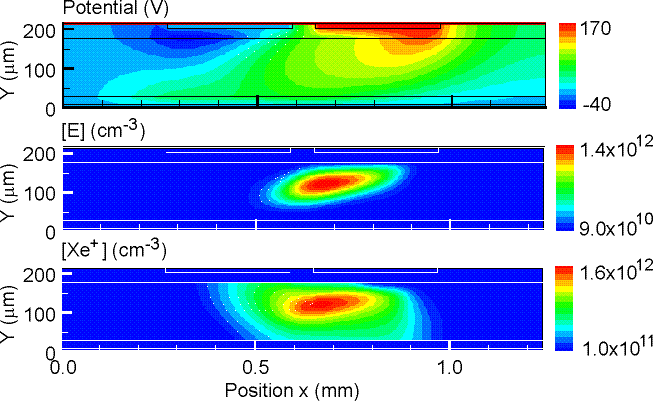

DEVELOPMENT OF A 2-DIMENSIONAL HYBRID PLASMA DISPLAY PANEL MODELING TOOL*
Shahid Rauf and
Mark J. Kushner
Department of Electrical & Computer Engineering
University of Illinois at Urbana-Champaign
1406 W. Green St., Urbana, IL 61801
1. Introduction
Plasma display panels (PDP) are one of the leading technologies currently under consideration for large screen flat panel displays. Since PDP cells are small and have limited diagnostic access, computer modeling has proven useful for understanding their physics and optimizing their operation. We have recently developed a new 2-dimensional hybrid PDP simulation. It is presently being used to investigate the consequences of cell geometry and gas chemistry on the displayís performance.
2. Computational Model
The basic model consists of solving Poissonís equation, the electron energy conservation equation and continuity equations for all species. The drift-diffusion approximation has been used for the flux of all species. The coupled set of Poissonís and charged species continuity equations are integrated implicitly in time using Newtonís method and sparse matrix techniques. The remaining equations are solved explicitly. The computed electron temperature is used in conjunction with a pre-computed lookup table from the solution of Boltzmannís equation to determine source functions for electron impact reactions and electron transport coefficients. The basic model is augmented with a Monte Carlo simulation for secondary electrons emitted from surfaces, a radiation transport model for computing visible light emission and a circuit model to take account of plasma-circuit interaction. Reaction mechanisms have been formulated for He, Ne, Xe and their mixtures.
3. Results
The model has been used to simulate He/Ne/Xe discharges for the opposing and adjacent electrode PDP cell designs. In the adjacent electrode geometry, breakdown occurs across the cell during the first pulse and shifts to a surface type discharge from the second pulse onwards. We are investigating the mechanisms through which energy is transferred to the radiative species (i.e. Xe* and Xe2*), and how the process can be optimized by changing the cell dimensions, aspect ratio, location of electrodes and Xe concentration. We are also looking into the effect of He addition to the gas mixture.

Fig. 1: Potential, electron density and Xe+ density in an adjacent electrode PDP cell.
Shown above are the potential, electron density and Xe+ density during the second discharge pulse in an adjacent electrode PDP cell. +180 V have been applied to the anode (right electrode), while the cathode (left electrode) and bottom plate are kept at ground potential. The gas mixture is He/Ne/Xe=70/26/4 at 400 Torr. Electrons can be seen to be pulled towards the anode. These electrons are charging the dielectric below the anode, which is making bulk of the potential drop across the dielectric. The ions are slowly drifting towards the cathode.
*This work is sponsored by LG Electronics Inc., Korea.
Last updated: September 30, 1998.